Руководства пользователя
- Руководства пользователя
- Декларация соответствия
Версия G12293
3 MB
PRIME_Z270-A_AR BIOS Manual(German)
Версия F12293
3.02 MB
PRIME_Z270-A_AR BIOS Manual(French)
Версия G12294
7.05 MB
PRIME Z270-A User’s Manual(German)
Версия E12293
8.42 MB
PRIME_Z270-A_AR_BIOS Manual(English)
Версия Q11956
1.22 MB
PRIME Z270-A QUICK START GUIDE
Версия —
342.45 KB
DJ170_Windows_7_Setup_Guide
Версия —
1.22 MB
DT170_Windows_7_Setup_Guide
Версия —
460.3 KB
DG170_Windows_7_Setup_Guide
Версия —
1.2 MB
DE170_Windows_7_Setup_Guide
Версия —
1.2 MB
DC170_Windows_7_Setup_Guide
Версия T12294
9 MB
PRIME Z270-A User’s manual ( Traditional Chinese )
Версия J11956
6.42 MB
PRIME Z270-A User’s manual ( JAPANESE)
Версия G11956
7.04 MB
PRIME Z270-A User’s manual ( GERMAN )
Версия F11956
7.08 MB
PRIME Z270-A User’s manual ( FRENCH )
Версия E12294
9.85 MB
PRIME Z270-A User’s manual ( ENGLISH )
Версия C12294
8.79 MB
PRIME Z270-A User’s manual ( Simplified Chinese )
-
Драйверы
21
-
Инструкции по эксплуатации
2
Языки:

ASUS PRIME Z270-A инструкция по эксплуатации
(104 страницы)
- Языки:Французский
-
Тип:
PDF -
Размер:
7.08 MB -
Описание:
PRIME Z270-A User’s manual ( FRENCH )
PRIME Z270-A User’s manual ( FRENCH )
Просмотр

ASUS PRIME Z270-A инструкция по эксплуатации
(104 страницы)
- Языки:Японский
-
Тип:
PDF -
Размер:
6.42 MB -
Описание:
PRIME Z270-A User’s manual ( JAPANESE)
PRIME Z270-A User’s manual ( JAPANESE)
Просмотр
На NoDevice можно скачать инструкцию по эксплуатации для ASUS PRIME Z270-A. Руководство пользователя необходимо для ознакомления с правилами установки и эксплуатации ASUS PRIME Z270-A. Инструкции по использованию помогут правильно настроить ASUS PRIME Z270-A, исправить ошибки и выявить неполадки.


E12294
Revised Edition V2
December 2016
Copyright© 2016 ASUSTeK COMPUTER INC. All Rights Reserved.
No part of this manual, including the products and software described in it, may be reproduced, transmitted, transcribed, stored in a retrieval system, or translated into any language in any form or by any means, except documentation kept by the purchaser for backup purposes, without the express written permission of ASUSTeK COMPUTER INC. (“ASUS”).
Product warranty or service will not be extended if: (1) the product is repaired, modified or altered, unless such repair, modification of alteration is authorized in writing by ASUS; or (2) the serial number of the product is defaced or missing.
ASUS PROVIDES THIS MANUAL “AS IS” WITHOUT WARRANTY OF ANY KIND, EITHER EXPRESS OR IMPLIED, INCLUDING BUT NOT LIMITED TO THE IMPLIED WARRANTIES OR CONDITIONS OF MERCHANTABILITY OR FITNESS FOR A PARTICULAR PURPOSE. IN NO EVENT SHALL ASUS, ITS DIRECTORS, OFFICERS, EMPLOYEES OR AGENTS BE LIABLE FOR ANY INDIRECT, SPECIAL, INCIDENTAL, OR CONSEQUENTIAL DAMAGES (INCLUDING DAMAGES FOR LOSS OF PROFITS, LOSS OF BUSINESS, LOSS OF USE OR DATA, INTERRUPTION OF BUSINESS AND THE LIKE), EVEN IF ASUS HAS BEEN ADVISED OF THE POSSIBILITY OF SUCH DAMAGES ARISING FROM ANY DEFECT OR ERROR IN THIS MANUAL OR PRODUCT.
SPECIFICATIONS AND INFORMATION CONTAINED IN THIS MANUAL ARE FURNISHED FOR INFORMATIONAL USE ONLY, AND ARE SUBJECT TO CHANGE AT ANY TIME WITHOUT NOTICE, AND SHOULD NOT BE CONSTRUED AS A COMMITMENT BY ASUS. ASUS ASSUMES NO RESPONSIBILITY OR LIABILITY FOR ANY ERRORS OR INACCURACIES THAT MAY APPEAR IN THIS MANUAL, INCLUDING THE PRODUCTS AND SOFTWARE DESCRIBED IN IT.
Products and corporate names appearing in this manual may or may not be registered trademarks or copyrights of their respective companies, and are used only for identification or explanation and to the owners’ benefit, without intent to infringe.
Offer to Provide Source Code of Certain Software
This product contains copyrighted software that is licensed under the General Public License (“GPL”), under the Lesser General Public License Version (“LGPL”) and/or other Free Open Source Software Licenses. Such software in this product is distributed without any warranty to the extent permitted by the applicable law. Copies of these licenses are included in this product.
Where the applicable license entitles you to the source code of such software and/or other additional data, you may obtain it for a period of three years after our last shipment of the product, either
(1)for free by downloading it from https://www.asus.com/support/
or
(2)for the cost of reproduction and shipment, which is dependent on the preferred carrier and the location where you want to have it shipped to, by sending a request to:
ASUSTeK Computer Inc.
Legal Compliance Dept.
15 Li Te Rd.,
Beitou, Taipei 112
Taiwan
In your request please provide the name, model number and version, as stated in the About Box of the product for which you wish to obtain the corresponding source code and your contact details so that we can coordinate the terms and cost of shipment with you.
The source code will be distributed WITHOUT ANY WARRANTY and licensed under the same license as the corresponding binary/object code.
This offer is valid to anyone in receipt of this information.
ASUSTeK is eager to duly provide complete source code as required under various Free Open Source Software licenses. If however you encounter any problems in obtaining the full corresponding source code we would be much obliged if you give us a notification to the email address gpl@asus.com, stating the product and describing the problem (please DO NOT send large attachments such as source code archives, etc. to this email address).
ii

Contents
|
Safety information………………………………………………………………………………………… |
vi |
|
About this guide…………………………………………………………………………………………… |
vii |
|
PRIME Z270-A specifications summary………………………………………………………….. |
ix |
|
Package contents………………………………………………………………………………………… |
xv |
|
Installation tools and components……………………………………………………………….. |
xvi |
|
Chapter 1: |
Product Introduction |
||
|
1.1 |
Motherboard overview……………………………………………………………………. |
1-1 |
|
|
1.1.1 |
Before you proceed…………………………………………………………… |
1-1 |
|
|
1.1.2 |
Motherboard layout……………………………………………………………. |
1-2 |
|
|
1.1.3 |
Central Processing Unit (CPU)……………………………………………. |
1-4 |
|
|
1.1.4 |
System memory………………………………………………………………… |
1-5 |
|
|
1.1.5 |
Expansion slots…………………………………………………………………. |
1-7 |
|
|
1.1.6 |
Onboard buttons and switches……………………………………………. |
1-9 |
|
|
1.1.7 |
Jumpers…………………………………………………………………………. |
1-11 |
|
|
1.1.8 |
Onboard LEDs………………………………………………………………… |
1-13 |
|
|
1.1.9 |
Internal connectors………………………………………………………….. |
1-15 |
|
Chapter 2: |
Basic Installation |
||
|
2.1 |
Building your PC system………………………………………………………………… |
2-1 |
|
|
2.1.1 |
Motherboard installation…………………………………………………….. |
2-1 |
|
|
2.1.2 |
CPU installation………………………………………………………………… |
2-3 |
|
|
2.1.3 |
CPU heatsink and fan assembly installation………………………….. |
2-5 |
|
|
2.1.4 |
DIMM installation………………………………………………………………. |
2-7 |
|
|
2.1.5 |
ATX power connection……………………………………………………….. |
2-8 |
|
|
2.1.6 |
SATA device connection…………………………………………………….. |
2-8 |
|
|
2.1.7 |
Front I/O connector……………………………………………………………. |
2-9 |
|
|
2.1.8 |
Expansion card installation……………………………………………….. |
2-10 |
|
|
2.1.9 |
M.2 installation………………………………………………………………… |
2-11 |
|
|
2.2 |
Motherboard rear and audio connections………………………………………. |
2-12 |
|
|
2.2.1 |
Rear I/O connection…………………………………………………………. |
2-12 |
|
|
2.2.2 |
Audio I/O connections………………………………………………………. |
2-14 |
|
|
2.3 |
Starting up for the first time………………………………………………………….. |
2-16 |
|
|
2.4 |
Turning off the computer………………………………………………………………. |
2-16 |
iii

|
Chapter 3: |
BIOS Setup |
||
|
3.1 |
Knowing BIOS………………………………………………………………………………… |
3-1 |
|
|
3.2 |
BIOS setup program……………………………………………………………………….. |
3-2 |
|
|
3.2.1 |
EZ Mode………………………………………………………………………….. |
3-3 |
|
|
3.2.2 |
Advanced Mode………………………………………………………………… |
3-4 |
|
|
3.2.3 |
QFan Control……………………………………………………………………. |
3-7 |
|
|
3.2.4 |
EZ Tuning Wizard……………………………………………………………… |
3-9 |
|
|
3.3 |
My Favorites…………………………………………………………………………………. |
3-12 |
|
|
3.4 |
Main menu……………………………………………………………………………………. |
3-14 |
|
|
3.5 |
Ai Tweaker menu………………………………………………………………………….. |
3-14 |
|
|
3.6 |
Advanced menu……………………………………………………………………………. |
3-16 |
|
|
3.6.1 |
CPU Configuration…………………………………………………………… |
3-16 |
|
|
3.6.2 |
Platform Misc Configuration………………………………………………. |
3-17 |
|
|
3.6.3 |
System Agent (SA) Configuration………………………………………. |
3-17 |
|
|
3.6.4 |
PCH Configuration…………………………………………………………… |
3-17 |
|
|
3.6.5 |
PCH Storage Configuration………………………………………………. |
3-17 |
|
|
3.6.6 |
PCH-FW Configuration…………………………………………………….. |
3-18 |
|
|
3.6.7 |
Thunderbolt(TM) Configuration………………………………………….. |
3-18 |
|
|
3.6.8 |
Onboard Devices Configuration…………………………………………. |
3-19 |
|
|
3.6.9 |
APM Configuration…………………………………………………………… |
3-20 |
|
|
3.6.10 |
Network Stack Configuration…………………………………………….. |
3-20 |
|
|
3.6.11 |
HDD/SSD SMART Information………………………………………….. |
3-20 |
|
|
3.6.12 |
USB Configuration…………………………………………………………… |
3-20 |
|
|
3.7 |
Monitor menu……………………………………………………………………………….. |
3-21 |
|
|
3.8 |
Boot menu……………………………………………………………………………………. |
3-21 |
|
|
3.9 |
Tool menu…………………………………………………………………………………….. |
3-23 |
|
|
3.9.1 |
ASUS EZ Flash 3 Utility……………………………………………………. |
3-23 |
|
|
3.9.2 |
Secure Erase………………………………………………………………….. |
3-24 |
|
|
3.9.3 |
ASUS Overclocking Profile……………………………………………….. |
3-25 |
|
|
3.9.4 |
ASUS SPD Information…………………………………………………….. |
3-25 |
|
|
3.9.5 |
Graphics Card Information………………………………………………… |
3-25 |
|
|
3.10 |
Exit menu……………………………………………………………………………………… |
3-26 |
|
|
3.11 |
Updating BIOS……………………………………………………………………………… |
3-27 |
|
|
3.11.1 |
EZ Update………………………………………………………………………. |
3-27 |
|
|
3.11.2 |
ASUS EZ Flash 3…………………………………………………………….. |
3-28 |
|
|
3.11.3 |
ASUS CrashFree BIOS 3…………………………………………………. |
3-30 |
iv

|
Chapter 4: |
RAID Support |
||
|
4.1 |
RAID configurations……………………………………………………………………….. |
4-1 |
|
|
4.1.1 |
RAID definitions………………………………………………………………… |
4-1 |
|
|
4.1.2 |
Installing Serial ATA hard disks…………………………………………… |
4-2 |
|
|
4.1.3 |
Intel® Rapid Storage Technology in UEFI BIOS…………………….. |
4-2 |
|
|
4.1.4 |
Intel® Rapid Storage Technology Option ROM utility………………. |
4-6 |
|
|
4.2 |
Creating a RAID driver disk…………………………………………………………… |
4-10 |
|
|
4.2.1 |
Creating a RAID driver disk in Windows® …………………………… |
4-10 |
|
|
Appendix |
|||
|
Notices |
……………………………………………………………………………………………………… |
A-1 |
|
|
ASUS contact information………………………………………………………………………….. |
A-5 |
v

Safety information
Electrical safety
•To prevent electrical shock hazard, disconnect the power cable from the electrical outlet before relocating the system.
•When adding or removing devices to or from the system, ensure that the power cables for the devices are unplugged before the signal cables are connected. If possible, disconnect all power cables from the existing system before you add a device.
•Before connecting or removing signal cables from the motherboard, ensure that all power cables are unplugged.
•Seek professional assistance before using an adapter or extension cord. These devices could interrupt the grounding circuit.
•Ensure that your power supply is set to the correct voltage in your area. If you are not sure about the voltage of the electrical outlet you are using, contact your local power company.
•If the power supply is broken, do not try to fix it by yourself. Contact a qualified service technician or your retailer.
Operation safety
•Before installing the motherboard and adding devices on it, carefully read all the manuals that came with the package.
•Before using the product, ensure all cables are correctly connected and the power cables are not damaged. If you detect any damage, contact your dealer immediately.
•To avoid short circuits, keep paper clips, screws, and staples away from connectors, slots, sockets and circuitry.
•Avoid dust, humidity, and temperature extremes. Do not place the product in any area where it may become wet.
•Place the product on a stable surface.
•If you encounter technical problems with the product, contact a qualified service technician or your retailer.
vi

About this guide
This user guide contains the information you need when installing and configuring the motherboard.
How this guide is organized
This guide contains the following parts:
1.Chapter 1: Product Introduction
This chapter describes the features of the motherboard and the new technology it supports. It includes description of the switches, jumpers, and connectors on the motherboard.
2.Chapter 2: Basic Installation
This chapter lists the hardware setup procedures that you have to perform when installing system components.
3.Chapter 3: BIOS Setup
This chapter tells how to change system settings through the BIOS Setup menus. Detailed descriptions of the BIOS parameters are also provided.
4.Chapter 4: RAID Support
This chapter describes the RAID configurations.
Where to find more information
Refer to the following sources for additional information and for product and software updates.
1.ASUS website
The ASUS website (www.asus.com) provides updated information on ASUS hardware and software products.
2.Optional documentation
Your product package may include optional documentation, such as warranty flyers, that may have been added by your dealer. These documents are not part of the standard package.
vii

Conventions used in this guide
To ensure that you perform certain tasks properly, take note of the following symbols used throughout this manual.
DANGER/WARNING: Information to prevent injury to yourself when trying to complete a task.
CAUTION: Information to prevent damage to the components when trying to complete a task.
IMPORTANT: Instructions that you MUST follow to complete a task.
NOTE: Tips and additional information to help you complete a task.
Typography
|
Bold text |
Indicates a menu or an item to select. |
|
Italics |
Used to emphasize a word or a phrase. |
|
<Key> |
Keys enclosed in the less-than and greater-than sign |
|
means that you must press the enclosed key. |
|
|
Example: <Enter> means that you must press the Enter or |
|
|
Return key. |
|
|
<Key1> + <Key2> + <Key3> |
If you must press two or more keys simultaneously, the key |
|
names are linked with a plus sign (+). |
viii

PRIME Z270-A specifications summary
|
Intel® Socket 1151 for 7th / 6th Generation Core™ i7/Core™ i5/Core™ i3/ |
||
|
Pentium®/Celeron® Processors |
||
|
CPU |
Supports 14nm CPU |
|
|
Supports Intel® Turbo Boost Technology 2.0* |
||
|
* Support of these features depends on the CPU types. |
||
|
Chipset |
Intel® Z270 Chipset |
|
|
4 x DIMM, max. 64GB DDR4 3866(O.C.) / 3733(O.C.) / 3600(O.C.) / |
||
|
3466(O.C.) / 3400(O.C.) / 3333(O.C.) / 3300(O.C.) / 3200(O.C.) / |
||
|
3000(O.C.) / 2800(O.C.) / 2666(O.C.) / 2400(O.C.) / 2133(O.C.) MHz |
||
|
Non-ECC, Un-buffered Memory |
||
|
Memory |
Dual channel memory architecture |
|
|
Supports Intel® Extreme Memory Profile (XMP) |
||
|
* Hyper DIMM support is subject to the physical characteristics of individual CPUs. |
||
|
Please refer to Memory QVL (Qualified Vendors List) for details. |
||
|
2 x PCI Express 3.0/2.0 x16 slots (single at x16 or dual at x8/x8 mode) |
||
|
Expansion slots |
1 x PCI Express 3.0/2.0 x16 slot* (max. at x4 mode, compatible with PCIe x1, |
|
|
x2 and x4 devices) |
||
|
4 x PCI Express 3.0/2.0 x1 slots |
||
|
Integrated Graphics ProcessorIntel® HD Graphics support |
||
|
Multi-VGA output support: DisplayPort/HDMI/DVI-D ports |
||
|
Supports HDMI 1.4b with max. resolution 4096 x 2160@24Hz / 2560 x |
||
|
1600@60Hz |
||
|
Supports DisplayPort 1.2* with max. resolution 4096 x 2304@24Hz |
||
|
VGA |
Supports DVI-D with max. resolution 1920 x 1200@60Hz |
|
|
Supports Intel® InTru™ 3D/Quick Sync Video/Clear Video HD Technology/ |
||
|
Insider™ |
||
|
Supports up to 3 displays simultaneously |
||
|
Maximum shared memory of 1024MB |
||
|
* DP 1.2 Multi-Stream Transport compliant, supports DP 1.2 monitor daisy chain |
||
|
up to 3 displays |
||
|
Multi-GPU |
Supports NVIDIA® 2-Way SLI® Technology |
|
|
support |
Supports AMD® 3-Way CrossFireX™ Technology |
|
|
Intel® I219-V Gigabit LANDual interconnect between the integrated Media |
||
|
LAN |
Access Controller (MAC) and physical layer (PHY) |
|
|
ASUS LAN Guard |
||
|
ASUS Turbo LAN Utility |
||
|
Intel® Z270 Express Chipset |
||
|
— 6 x USB 3.0/2.0 ports (2 ports @mid-board, 4 ports @back panel, blue) |
||
|
USB |
— 6 x USB 2.0/1.1 ports (6 ports @mid-board) |
|
|
Asmedia® USB 3.1 controller — supports 3A power output |
||
|
— 1 x USB 3.1/3.0/2.0 port @back panel (teal blue, Type-A) |
||
|
— 1 x USB 3.1/3.0/2.0 port @back panel (Type-C) |
||
|
(continued on the next page) |
ix

PRIME Z270-A specifications summary
|
Intel® Z270 Express Chipset with RAID 0, 1, 5, 10 and Intel Rapid |
||
|
Storage Technology 15 support* |
||
|
— 1 x M.2 Socket 3 with M Key, type 2242/2260/2280/22110 storage devices |
||
|
support (both SATA & PCIE mode)** |
||
|
— 1 x M.2 Socket 3 with M Key, type 2242/2260/2280 storage devices |
||
|
support (PCIE mode only)*** |
||
|
— 6 x SATA 6.0 Gb/s ports (gray) |
||
|
— Ready for Intel® Optane Memory**** |
||
|
Storage |
— Supports Intel® Smart Response Technology***** |
|
|
* Supports PCIE RAID configurations via onboard M.2 storages. |
||
|
** The M.2_1 socket shares bandwidth with SATA_1 port when using M.2 SATA |
||
|
devices. Adjust BIOS settings to use a SATA device. |
||
|
*** The M.2_2 socket shares bandwidth with SATA_56 ports when using M.2 PCIE |
||
|
devices in X4 mode. Adjust BIOS settings to use M.2 PCIE devices in X4 mode. |
||
|
**** Intel® Optane Technology is only supported when using 7th Generation Intel® |
||
|
Processors. Before using Intel® Optane memory modules, ensure that you |
||
|
have updated your motherboard drivers and BIOS to the latest version from the |
||
|
ASUS support website. |
||
|
*****These functions will work depending on the CPU installed. |
||
|
Realtek® S1220A 8-channel high definition audio CODEC featuring |
||
|
Crystal Sound 3 |
||
|
— Power pre-regulator reduces power input noise to ensure consistent |
||
|
performance |
||
|
— Separate layer for left and right track, ensuring both sound deliver equal |
||
|
quality |
||
|
— Impendance sense for front and rear headphone outputs |
||
|
— Audio shielding ensures precise analog/digital separation and greatly |
||
|
reduced multi-lateral interference |
||
|
— EMI protection cover to prevent electrical noise to affect the amplifier |
||
|
quality |
||
|
— Internal audio amplifier to enhance the highest quality sound for |
||
|
Audio |
headphone and speakers |
|
|
— Unique de-pop circuit to reduce start-up popping noise to audio outputs |
||
|
— Premium Japan-made audio capacitors provides warm, natural, and |
||
|
immersive sound with exceptional clarity and fidelity |
||
|
— High quality 120dB SNR stereo playback output (Line-out@back) & 113dB |
||
|
SNR recording input (Line-in) support |
||
|
— Supports up to 32-Bit/192kHz playback* |
||
|
— DTS® HeadphoneX |
||
|
— DTS® Connect |
||
|
— Supports jack-detection, multi-streaming, front panel jack-retasking (MIC) |
||
|
— Optical S/PDIF out port at back I/O |
||
|
* Due to limitations in HDA bandwidth, 32-Bit/192kHz is not supported for |
||
|
8-Channel audio. 32-Bit/192kHz is only available under Windows® 10. |
||
|
(continued on the next page) |
x

PRIME Z270-A specifications summary
<Superb Performance>
OC Design: ASUS PRO Clock Technology
— Full BCLK range for extreme overclocking performance.
5-Way Optimization
— Whole system optimization with a single click! Perfectly consolidates better
CPU performance, power saving, digital power control, system cooling and app usages.
DIGI+ Power Control
—CPU Power: Digital 8-phase power design
—iGPU Power: Digital 2-phase power design
TPU
— Auto Tuning, GPU Boost
EPU
— EPU
Fan Xpert 4 featuring Fan Auto Tuning function and multiple thermistors selection for optimized system cooling control
Turbo App featuring system performance tuning, network priority, and audio scene configuration for selected applications.
UEFI BIOS
CrashFree BIOS 3 EZ Flash 3
EZ Tuning Wizard GPU Post S.M.A.R.T. Secure Erase
Special Memory O.C. Design
— Superb memory O.C. capability under full load by minimizing the coupling noise and signal reflection effect
<Connectivity>
32Gb/s M.2 onboard — PCIe 3.0 x4
Intel® Thunderbolt 3 Support
— Blistering-fast 40Gb/s data transfers upgrades with ThunderboltEX 3 Card.
<EZ Management>
File Transfer
—Cloud GO!
—File Transfer
PC Cleaner
— Fast and easy way to get rid of unnecessary junk files
(continued on the next page)
xi

PRIME Z270-A specifications summary
|
<Gaming> |
||
|
AURA Sync |
||
|
— Bright up your Build |
||
|
3D Printing Support |
||
|
— Make it your own. The new era of PC customization |
||
|
Turbo LAN |
||
|
— Fast and smooth online gaming with lower pings and less lags |
||
|
Turbo APP |
||
|
ASUS Exclusive |
— Tailored app performance, network priority and audio configuration for your |
|
|
needs |
||
|
Features |
||
|
<EZ DIY> |
||
|
CPU Installation Tool |
||
|
— Three-step simplicity and safety |
||
|
Q-Design |
||
|
— ASUS Q-Shield |
||
|
— ASUS Q-LED (CPU, DRAM, VGA, Boot Device LED) |
||
|
— ASUS Q-Slot |
||
|
— ASUS Q-DIMM |
||
|
— ASUS Q-Connector |
||
|
Special Features: |
||
|
ASUS SafeSlot |
||
|
— Protect your graphics card Investment |
||
|
ASUS 5X Protection III |
||
|
— ASUS SafeSlot Core — Fortified PCIe with solid soldering |
||
|
— ASUS LANGuard — Protects against LAN surges, lightning strikes and |
||
|
static-electricity discharges! |
||
|
ASUS Special |
— ASUS Overvoltage Protection — World-class circuit-protecting power |
|
|
design |
||
|
Features |
— ASUS DIGI+ VRM — 8+2 Phase digital power design |
|
|
— ASUS DRAM Overcurrent Protection: Enhanced DRAM overcurrent |
||
|
protection |
||
|
— ASUS Stainless — Steel Back I/O: 3X corrosion-resistance for greater |
||
|
durability! |
||
|
— ASUS ESD Guards — Enhanced ESD protection |
||
|
— AI Suite 3 |
||
|
— Ai Charger |
||
|
— MemOK! |
||
|
ASUS Quiet |
Quiet Thermal Design: |
|
|
— ASUS Fan Xpert 4 |
||
|
Thermal |
||
|
Solution |
— ASUS Fanless Design: Heat-sink solution |
|
|
(continued on the next page) |
xii

PRIME Z270-A specifications summary
|
Precision Tweaker 2: |
|
|
— CPU Core/Cache Voltage: Adjustable CPU Core/Cache Voltage at 0.005V |
|
|
increment |
|
|
— CPU Graphics Voltage: Adjustable CPU Graphics voltage at 0.005V |
|
|
increment |
|
|
— CPU VCCIO Voltage: Adjustable CPU VCCIO Voltage at 0.0125V |
|
|
increment |
|
|
ASUS Exclusive |
— CPU System Agent Voltage: Adjustable CPU System Agent Voltage at |
|
Overclocking |
0.0125V increment |
|
Features |
— DRAM Voltage: 152-step Memory voltage control |
|
— PCH Core Voltage: 110-step Chipset voltage control |
|
SFS (Stepless Frequency Selection) |
|||
|
— BCLK/PCIE frequency tuning from 40MHz up to 500MHz at 0.01MHz |
|||
|
increment |
|||
|
Overclocking Protection: |
|||
|
— ASUS C.P.R.(CPU Parameter Recall) |
|||
|
1 x USB 3.0/2.0 connectors support additional 2 USB ports (19-pin) |
|||
|
3 x USB 2.0/1/1 connectors support additional 6 USB ports |
|||
|
1 x M.2 Socket 3 (for M Key, type 2242/2260/2280 devices, PCIE mode) |
|||
|
1 x M.2 Socket 3 (for M Key, type 2242/2260/2280/22110 devices, PCIE & |
|||
|
SATA mode) |
|||
|
6 x SATA 6.0Gb/s connectors (gray) |
|||
|
1 x CPU Fan header (4-pin) for both 3-pin(DC mode) and 4-pin(PWM mode) |
|||
|
CPU coolers control with auto detection support |
|||
|
1 x CPU OPT Fan header (4-pin) |
|||
|
1 x AIO Pump header (4-pin) |
|||
|
1 x High AMP Fan header (4-pin) |
|||
|
2 x Chassis Fan connectors (4-pin) for both 3-pin(DC mode) and 4-pin(PWM |
|||
|
mode) coolers control with auto detection support |
|||
|
Internal I/O |
1 x RGB header |
||
|
2 x 3D Mount screw ports |
|||
|
connectors |
|||
|
1 x Front panel audio connector (AAFP) |
|||
|
1 x Thunderbolt header (5-pin) for ASUS ThunderboltEX series support |
|||
|
1 x TPM connector |
|||
|
1 x COM connector |
|||
|
1 x 24-pin EATX Power connector |
|||
|
1 x 8-pin EATX 12V Power connector |
|||
|
1 x System Panel (Q-Connector) |
|||
|
1 x MemOK! button |
|||
|
1 x Power-on button |
|||
|
1 x CPU OV jumper |
|||
|
1 x Clear CMOS header |
|||
|
1 x EZ XMP switch |
|||
|
1 x 5-pin EXT_FAN (Extension Fan) connector |
|||
|
(continued on the next page) |
xiii

PRIME Z270-A specifications summary
|
1 x DisplayPort |
||
|
1 x HDMI port |
||
|
1 x DVI-D |
||
|
Back Panel I/O |
1 x Optical S/PDIF out |
|
|
1 x Intel LAN (RJ45) port |
||
|
Ports |
||
|
1 x USB 3.1/3.0/2.0 port (teal blue, Type A) |
||
|
1 x USB 3.1/3.0/2.0 port (Type C) |
||
|
4 x USB 3.0/2.0 ports (blue) |
||
|
8-channel Audio I/O ports |
||
|
128 Mb Flash ROM, UEFI AMI BIOS, PnP, WfM2.0, SM BIOS 3.0, ACPI |
||
|
6.0, Multi-language BIOS, ASUS EZ Flash 3, CrashFree BIOS 3, F11 EZ |
||
|
BIOS Features |
Tuning Wizard, F6 Qfan Control, F3 My Favorites, Last Modified log, F12 |
|
|
PrintScreen, and ASUS DRAM SPD (Serial Presence Detect) memory |
||
|
information. |
||
|
Manageability |
WfM 2.0, DMI 3.0, WOL by PME, PXE |
|
|
Drivers |
||
|
Support DVD |
ASUS Utilities |
|
|
contents |
EZ Update |
|
|
Anti-virus software (OEM version) |
||
|
Windows® 10 64-bit |
||
|
Operating |
Windows® 8.1 64-bit* |
|
|
Windows® 7* |
||
|
system support |
||
|
* Windows® 8.1 64-bit and Windows® 7 32/64-bit are only supported when using |
||
|
6th Generation Intel® Processors |
||
|
Form factor |
ATX Form Factor, 12”x 9.6” (30.5cm x 24.4cm) |
|
• Specifications are subject to change without notice.
• Visit the ASUS website for the software manual.
xiv

Package contents
Check your motherboard package for the following items:
Motherboard
3 x Serial ATA 6.0 Gb/s cables
ASUS PRIME Z270-A motherboard
2 x M.2 screw package
|
1 x Q-Connector |
1 x CPU Installation Tool |
1 x ASUS SLI HB BRIDGE(2-WAY-M) |
|
Manual |
||
|
User |
||
|
1 x ASUS Q-Shield |
1 x User Manual |
1 x Support DVD |
•If any of the above items is damaged or missing, contact your retailer.
•The illustrated items above are for reference only. Actual product specifications may vary with different models.
xv

Installation tools and components
Intel® LGA1151 CPU
Intel® LGA1151 compatible CPU Fan
|
SATA hard disk drive |
Phillips (cross) screwdriver |
|
PC chassis |
Power supply unit
SATA optical disc drive (optional)
Graphics card
The tools and components in the table above are not included in the motherboard package.
xvi

1.1Motherboard overview
1.1.1Before you proceed
Take note of the following precautions before you install motherboard components or change any motherboard settings.
•Unplug the power cord from the wall socket before touching any component.
•Before handling components, use a grounded wrist strap or touch a safely grounded object or a metal object, such as the power supply case, to avoid damaging them due to static electricity.
•Hold components by the edges to avoid touching the ICs on them.
•Whenever you uninstall any component, place it on a grounded antistatic pad or in the bag that came with the component.
•Before you install or remove any component, ensure that the ATX power supply is switched off or the power cord is detached from the power supply. Failure to do so may cause severe damage to the motherboard, peripherals, or components.
Chapter 1
|
ASUS PRIME Z270-A Series |
1-1 |
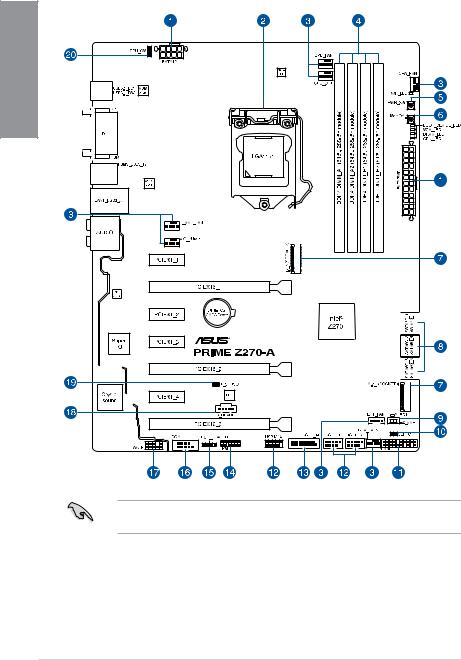
1.1.2Motherboard layout
1 Chapter
Refer to 1.1.9 Internal connectors and 2.2.1 Rear I/O connection for more information about rear panel connectors and internal connectors.
|
1-2 |
Chapter 1: Product Introduction |

Layout contents
|
Connectors/Jumpers/Buttons and switches/Slots |
Page |
|
|
1. |
ATX power connectors (24-pin EATXPWR; 8-pin EATX12V) |
1-20 |
|
2. |
LGA1151 CPU socket |
1-4 |
|
3. |
CPU, CPU optional, AIO pump, high amp, extension, and chassis fan |
1-19 |
|
connectors (4-pin CPU_FAN; 4-pin CPU_OPT; 4-pin AIO_PUMP; 4-pin |
||
|
H_AMP_FAN; 5-pin EXT_FAN; 4-pin CHA_FAN1-2) |
||
|
4. |
DDR4 DIMM slots |
1-5 |
|
5. |
Power-on button |
1-9 |
|
6. |
MemOK! button |
1-10 |
|
7. |
M.2 sockets (M.2_1(Socket 3); M.2_2(Socket 3)) |
1-23 |
|
8. |
Intel® Serial ATA 6 Gb/s connectors (7-pin SATA6G_12; SATA 6G_34; |
1-15 |
|
SATA 6G_56) |
||
|
9. |
EZ XMP switch |
1-9 |
|
10. |
Clear RTC RAM jumper (2-pin CLRTC) |
1-11 |
|
11. |
System panel connector (20-3 pin PANEL) |
1-21 |
|
12. |
USB 2.0 connectors (10-1 pin USB1314; USB910; USB1112) |
1-18 |
|
13. |
USB 3.0 connector (20-1 pin USB3_34) |
1-17 |
|
14. |
TPM connector (14-1 pin TPM) |
1-22 |
|
15. |
RGB header (4-pin RGB_HEADER) |
1-24 |
|
16. |
Serial port connector (10-1 pin COM) |
1-25 |
|
17. |
Front panel audio connector (10-1 pin AAFP) |
1-16 |
|
18. |
Thunderbolt header (5-pin TB_HEADER) |
1-22 |
|
19. |
Thermal sensor connector (2-pin T_SENSOR) |
1-25 |
|
20. |
CPU Over Voltage jumper (3-pin CPU_OV) |
1-12 |
Chapter 1
|
ASUS PRIME Z270-A Series |
1-3 |

1.1.3Central Processing Unit (CPU)
The motherboard comes with a surface mount LGA1151 socket designed for the 7th & 6th Generation Intel® Core™ i7 / Intel® Core™ i5 / Intel® Core™ i3, Pentium®, and Celeron® processors.
1 Chapter
•Ensure that all power cables are unplugged before installing the CPU.
•Upon purchase of the motherboard, ensure that the PnP cap is on the socket and the socket contacts are not bent. Contact your retailer immediately if the PnP cap is missing, or if you see any damage to the PnP cap/socket contacts/motherboard components. ASUS will shoulder the cost of repair only if the damage is shipment/ transit-related.
•Keep the cap after installing the motherboard. ASUS will process Return Merchandise Authorization (RMA) requests only if the motherboard comes with the cap on the LGA1151 socket.
•The product warranty does not cover damage to the socket contacts resulting from incorrect CPU installation/removal, or misplacement/loss/incorrect removal of the PnP cap.
|
1-4 |
Chapter 1: Product Introduction |

1.1.4System memory
The motherboard comes with four DDR4 (Double Data Rate 4) Quad Inline Memory Modules (DIMM) slots.
A DDR4 module is notched differently from a DDR, DDR2, or DDR3 module. DO NOT install a DDR, DDR2, or DDR3 memory module to the DDR4 slot.
Recommended memory configurations
Chapter 1
|
ASUS PRIME Z270-A Series |
1-5 |

1 Chapter
Memory configurations
You may install 1 GB, 2 GB, 4 GB, 8 GB and 16 GB unbuffered and non ECC DDR4 DIMMs into the DIMM sockets.
• You may install varying memory sizes in Channel A and Channel B. The system maps the total size of the lower-sized channel for the dual-channel configuration. Any excess memory from the higher-sized channel is then mapped for single-channel operation.
•Due to the memory address limitation on 32-bit Windows® OS, when you install 4 GB or more memory on the motherboard, the actual usable memory for the OS can be about 3 GB or less. For effective use of memory, we recommend that you do any of the following:
a)Use a maximum of 3GB system memory if you are using a 32-bit Windows® OS.
b)Install a 64-bit Windows® OS when you want to install 4 GB or more on the motherboard.
c)For more details, refer to the Microsoft® support site at http://support.microsoft. com/kb/929605/en-us.
•This motherboard does not support DIMMs made up of 512 Mb (64 MB) chips or less (Memory chip capacity counts in Megabit, 8 Megabit/Mb = 1 Megabyte/MB).
• The default memory operation frequency is dependent on its Serial Presence Detect (SPD), which is the standard way of accessing information from a memory module. Under the default state, some memory modules for overclocking may operate at a lower frequency than the vendor-marked value.
•For system stability, use a more efficient memory cooling system to support a full memory load (4 DIMMs) or overclocking condition.
•Always install the DIMMS with the same CAS Latency. For an optimum compatibility, we recommend that you install memory modules of the same version or data code (D/C) from the same vendor. Check with the vendor to get the correct memory modules.
|
1-6 |
Chapter 1: Product Introduction |

1.1.5Expansion slots
Unplug the power cord before adding or removing expansion cards. Failure to do so may cause you physical injury and damage motherboard components.
Chapter 1
Slot No. Slot Description
1PCIE 3.0/2.0 x1_1 slot
2PCIE 3.0/2.0 x16_1 slot
3PCIE 3.0/2.0 x1_2 slot 4 PCIE 3.0/2.0 x1_3 slot 5 PCIE 3.0/2.0 x16_2 slot
6PCIE 3.0/2.0 x1_4 slot
7PCIE 3.0/2.0 x16_3 slot
|
ASUS PRIME Z270-A Series |
1-7 |

1 Chapter
|
PCI Express 3.0 operating mode |
|||
|
VGA configuration |
|||
|
PCIe 3.0/2.0 x16_1 |
PCIe 3.0/2.0 x16_2 |
||
|
Single VGA/PCIe card |
x16 (single VGA |
N/A |
|
|
recommended) |
|||
|
Dual VGA/PCIe card |
x8 |
x8 |
|
•We recommend that you provide sufficient power when running CrossFireX™ or SLI® mode.
•Connect chassis fans to the motherboard chassis fan connectors when using multiple graphics cards for better thermal environment.
IRQ assignments for this motherboard
|
A |
B |
C |
D |
E |
F |
G |
H |
|
|
PCIe x16_1 |
shared |
— |
— |
— |
— |
— |
— |
— |
|
PCIe x16_2 |
shared |
— |
— |
— |
— |
— |
— |
— |
|
PCIe x16_3 |
shared |
— |
— |
— |
— |
— |
— |
— |
|
PCIe x1_1 |
shared |
— |
— |
— |
— |
— |
— |
— |
|
PCIe x1_2 |
— |
shared |
— |
— |
— |
— |
— |
— |
|
PCIe x1_3 |
— |
— |
shared |
— |
— |
— |
— |
— |
|
PCIe x1_4 |
— |
— |
— |
shared |
— |
— |
— |
— |
|
SMBUS Controller |
shared |
— |
— |
— |
— |
— |
— |
— |
|
Intel SATA Controller |
shared |
— |
— |
— |
— |
— |
— |
— |
|
Intel LAN1(i219) |
— |
— |
— |
shared |
— |
— |
— |
— |
|
Intel xHCI |
shared |
— |
— |
— |
— |
— |
— |
— |
|
HD Audio |
shared |
— |
— |
— |
— |
— |
— |
— |
|
ASMedia 2142 |
shared |
— |
— |
— |
— |
— |
— |
— |
|
1-8 |
Chapter 1: Product Introduction |

1.1.6Onboard buttons and switches
Onboard buttons and switches allow you to fine-tune performance when working on a bare or open-case system. This is ideal for overclockers and gamers who continually change settings to enhance system performance.
|
1 |
|||||||||||||||||||||||||||||||||||||||||||||||||||
|
1. |
Power-on button |
Chapter |
|||||||||||||||||||||||||||||||||||||||||||||||||
|
The motherboard comes with a power-on button that allows you to power up or wake |
|||||||||||||||||||||||||||||||||||||||||||||||||||
|
up the system. The LED near the button also lights up when the system is plugged to |
|||||||||||||||||||||||||||||||||||||||||||||||||||
|
a power source indicating that you should shut down the system and unplug the power |
|||||||||||||||||||||||||||||||||||||||||||||||||||
|
cable before removing or installing any motherboard component. |
|||||||||||||||||||||||||||||||||||||||||||||||||||
2.EZ XMP switch
Enable this switch to overclock the installed DIMMs, allowing you to enhance the DIMM’s speed and performance.
|
ASUS PRIME Z270-A Series |
1-9 |
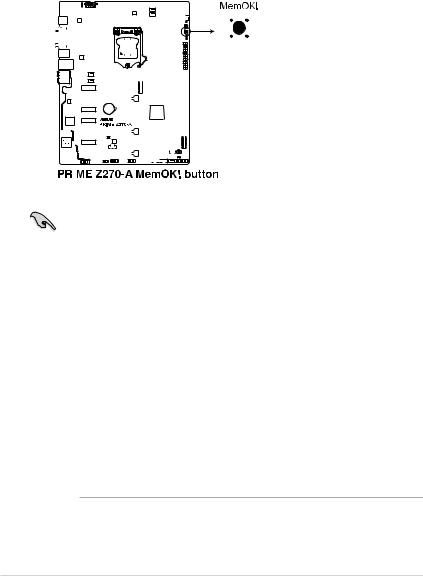
|
3. MemOK! button |
||||||||||||||||||||||||||||||||||||||||||||||||||||
|
Installing DIMMs that are not compatible with the motherboard may cause system boot |
||||||||||||||||||||||||||||||||||||||||||||||||||||
|
1Chapter |
failure. If the system fails to boot during POST stage and the DRAM_LED near the |
|||||||||||||||||||||||||||||||||||||||||||||||||||
|
MemOK! button lights continuously, press the MemOK! button until the DRAM_LED |
||||||||||||||||||||||||||||||||||||||||||||||||||||
|
starts blinking. System will begin automatic memory compatibility tuning and reboot for |
||||||||||||||||||||||||||||||||||||||||||||||||||||
|
successful boot. |
||||||||||||||||||||||||||||||||||||||||||||||||||||
•Refer to section 1.1.8 Onboard LEDs for the exact location of the DRAM_LED.
•The DRAM_LED also lights up when the DIMM is not properly installed. Turn off the system and reinstall the DIMM before using the MemOK! function.
•The MemOK! button does not function under Windows® OS environment.
•During the tuning process, the system loads and tests failsafe memory settings. It takes about 30 seconds for the system to test one set of failsafe settings. If the test fails, the system reboots and tests the next set of failsafe settings. The blinking speed of the DRAM_LED increases, indicating different test processes.
•Due to memory tuning requirement, the system automatically reboots when each timing set is tested. If the installed DIMMs still fail to boot after the whole tuning process, the DRAM_LED lights continuously. Replace the DIMMs with ones recommended in the Memory QVL (Qualified Vendors Lists) at www.asus.com.
•If you turn off the computer and replace DIMMs during the tuning process, the system continues memory tuning after turning on the computer. To stop memory tuning, turn off the computer and unplug the power cord for about 5–10 seconds.
•If your system fails to boot up due to BIOS overclocking, press the MemOK! button to boot and load the BIOS default settings. A message will appear during POST reminding you that the BIOS has been restored to its default settings.
•We recommend that you download and update to the latest BIOS version from www.asus.com after using the MemOK! function.
|
1-10 |
Chapter 1: Product Introduction |
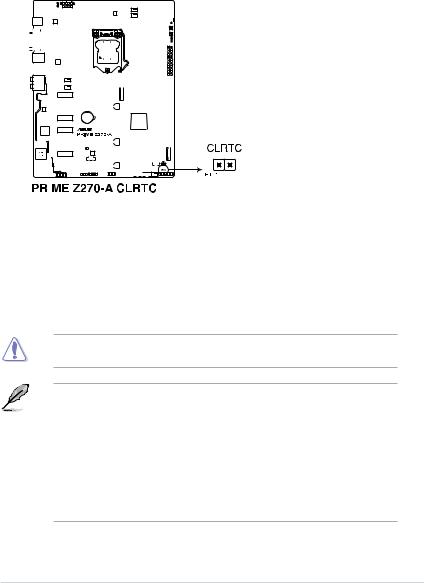
1.1.7Jumpers
|
1. Clear RTC RAM jumper (2-pin CLRTC) |
|||||||||||||||||||||||||||||||||||||||||||||||
|
This jumper allows you to clear the Real Time Clock (RTC) RAM in CMOS. You can |
|||||||||||||||||||||||||||||||||||||||||||||||
|
clear the CMOS memory of date, time, and system setup parameters by erasing the |
1 |
||||||||||||||||||||||||||||||||||||||||||||||
|
CMOS RTC RAM data. The onboard button cell battery powers the RAM data in |
|||||||||||||||||||||||||||||||||||||||||||||||
|
Chapter |
|||||||||||||||||||||||||||||||||||||||||||||||
|
CMOS, which include system setup information such as system passwords. |
|||||||||||||||||||||||||||||||||||||||||||||||
To erase the RTC RAM:
1.Turn OFF the computer and unplug the power cord.
2.Short-circuit pin 1-2 with a metal object or jumper cap for about 5-10 seconds.
3.Plug the power cord and turn ON the computer.
4.Hold down the <Delete> key during the boot process and enter BIOS setup to re-enter data.
Except when clearing the RTC RAM, never place a metal object or jumper cap on the
CLRTC jumper. Placing a metal object or jumper cap will cause system boot failure!
•If the steps above do not help, remove the onboard battery and place a metal object or jumper cap again to clear the CMOS RTC RAM data. After the CMOS clearance, reinstall the battery.
•You do not need to clear the RTC when the system hangs due to overclocking. For system failure due to overclocking, use the C.P.R. (CPU Parameter Recall) feature. Shut down and reboot the system so the BIOS can automatically reset parameter settings to default values.
•Due to the chipset behavior, AC power off is required to enable C.P.R. function. You must turn off and turn on the power supply or unplug and plug the power cord before rebooting the system.
|
ASUS PRIME Z270-A Series |
1-11 |
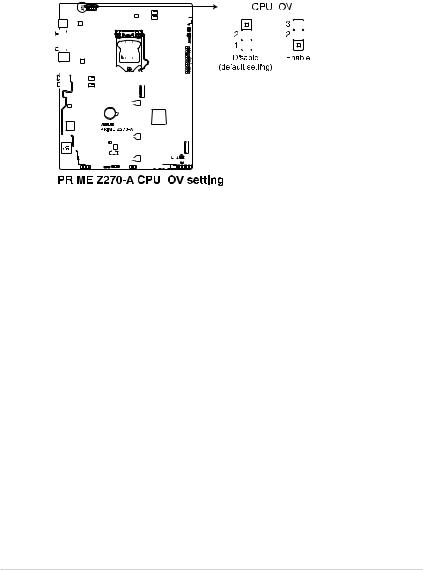
|
2. |
CPU Over Voltage jumper (3-pin CPU_OV) |
|||||||||||||||||||||||||||||||||||||||||||||||||
|
The CPU Over Voltage jumper allows you to set a higher CPU voltage for a flexible |
||||||||||||||||||||||||||||||||||||||||||||||||||
|
1Chapter |
overclocking system, depending on the type of the installed CPU. To gain more CPU |
|||||||||||||||||||||||||||||||||||||||||||||||||
|
voltage setting, insert the jumper to pins 2-3. To go back to its default CPU voltage |
||||||||||||||||||||||||||||||||||||||||||||||||||
|
setting, insert the jumper to pins 1-2. |
||||||||||||||||||||||||||||||||||||||||||||||||||
|
1-12 |
Chapter 1: Product Introduction |
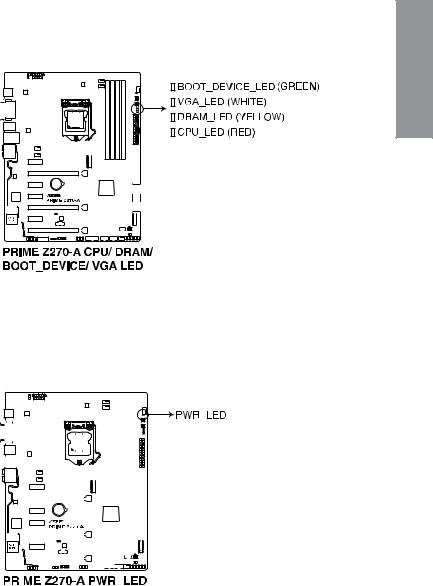
1.1.8Onboard LEDs
|
1. |
POST State LEDs |
|
|
The POST State LEDs provide the status of these key components during POST |
||
|
(Power-On Self-Test): CPU, memory modules, VGA card, and hard disk drives. If an |
1 |
|
|
error is found, the critical component’s LED stays lit up until the problem is solved. |
||
|
Chapter |
||
2.Standby Power LED
The motherboard comes with a standby power LED. The LED lights up to indicate that the system is ON, in sleep mode, or in soft-off mode. This is a reminder that you should shut down the system and unplug the power cable before removing or plugging in any motherboard component. The illustration below shows the location of the onboard LED.
|
ASUS PRIME Z270-A Series |
1-13 |

3.EZ XMP LED (XLED1)
This LED lights up when you enable the EZ XMP switch.
1 Chapter
|
1-14 |
Chapter 1: Product Introduction |

1.1.9Internal connectors
|
1. |
Intel® Serial ATA 6 Gb/s connectors (7-pin SATA6G_12; SATA 6G_34; |
|||||||||||||||||||||||||||||||||||||||||||||||||
|
SATA 6G_56) |
||||||||||||||||||||||||||||||||||||||||||||||||||
|
These connectors connect to Serial ATA 6 Gb/s hard disk drives via Serial ATA 6 Gb/s |
1 |
|||||||||||||||||||||||||||||||||||||||||||||||||
|
signal cables. |
Chapter |
|||||||||||||||||||||||||||||||||||||||||||||||||
|
If you installed Serial ATA hard disk drives, you can create a RAID 0, 1, 5, and 10 |
||||||||||||||||||||||||||||||||||||||||||||||||||
|
configuration with the Intel® Rapid Storage Technology through the onboard Intel® |
||||||||||||||||||||||||||||||||||||||||||||||||||
|
Z270 chipset. |
||||||||||||||||||||||||||||||||||||||||||||||||||
These connectors are set to [AHCI Mode] by default. If you intend to create a Serial ATA
RAID set using these connectors, set the SATA Mode item in the BIOS to [Intel RST
Premium With Intel Optane System Acceleration (RAID)].
|
ASUS PRIME Z270-A Series |
1-15 |

|
2. |
Front panel audio connector (10-1 pin AAFP) |
|
This connector is for a chassis-mounted front panel audio I/O module that supports HD |
|
|
1 Chapter |
Audio. Connect one end of the front panel audio I/O module cable to this connector. |
We recommend that you connect a high-definition front panel audio module to this connector to avail of the motherboard’s high-definition audio capability.
|
1-16 |
Chapter 1: Product Introduction |
 Loading…
Loading…
